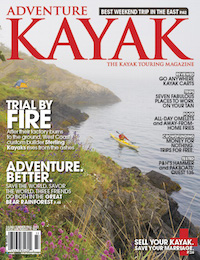Recently, international development workers have identified a new and surprisingly effective tool: the kayak.
As a sea kayak guide who spends much of my time working in the Arctic or overseas, I am well acquainted with the remarkable way in which our crafts glide smoothly through linguistic, social, physical and economic barriers. But in early 2012, my jaw hit the deck when I saw a volunteer posting for kayak instructors to work on a development project in Tanzania.
I applied for and got the posting, and in May headed to East Africa to share my kayaking skills with instructors at the National College of Tourism (NCT) in the bustling coastal city and commercial capital of Dar es Salaam.
For this final stage of a three-year, Canadian International Development Agency (CIDA)-funded partnership with the College of the Rockies in British Columbia, NCT had requested help developing marine tourism modules for their Tourism Diploma program, including kayak training for their instructors.
The request fit in neatly with the partnership’s aim to help Tanzania diversify their tourism products. Home to half of the world’s remaining wild lions and the two largest protected areas in Africa, Tanzania is well known amongst ecotourists for inland attractions like Serengeti National Park, Ngorongoro Crater, Gombe Chimp Park and Mount Kilimanjaro. But other than the history-rich Spice Island of Zanzibar, there is little in the way of developed tourism along the endless white sand beaches and crystal clear waters of the country’s Swahili Coast. Dynamite fishing threatens Tanzania’s world-class reefs and marine life, and tourism is seen as a way for locals to put a different value on marine resources.
Aside from the challenges of shifting a resource harvesting-based economy to one built on conservation and tourism, we faced another daunting hurdle. Tanzanians are terrified of water. In a country where hippos, crocodiles and tropical parasites plague inland waters, young children are taught that entering the water equals certain death. Few people swim, including our would-be kayak instructor counterparts. Our kayak and snorkel program evolved on the spot into a just-get- wet and learn to swim program.
Easing the instructors into a hotel pool made us doubt whether we’d ever actually get anyone seated in CIDA’s secret weapons. At pool’s edge, 12 pairs of eyes, wide with terror, looked dubiously at the tranquil water. Finally, one brave soul stepped in, and soon it was like summer camp.
We graduated to a safe beach for more swim practice and, finally, paddling. The program supplied NCT with sit-on-top kayaks, pad- dles and all necessary safety gear. We spent eight days practicing basic strokes and rescues and enjoying the stellar paddling and marine life of the Indian Ocean.
Nine months later, I was back in Tanzania to conduct follow-up training, introducing basic instruction skills. The same men and women who had trembled at the sight of a swimming pool less than a year before now led me eagerly to favorite paddling sites they had discovered along the coast.
With a little help, Tanzanians are embracing a bright future, one built not on the old adage “ Teach a man to fish…” but on a new, inspired wisdom that begins with,“Teach a person to kayak…”
This article first appeared in Adventure Kayak, Early Summer 2013. Download our free iPad/iPhone/iPod Touch App or Android App or read here for free.



